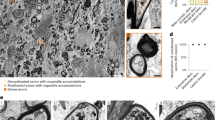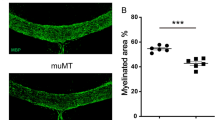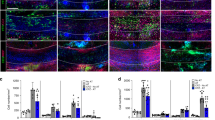Abstract
Multiple sclerosis (MS) is a chronic inflammatory disease of the central nervous system (CNS)1. So far, immunological mechanisms responsible for demyelination have been the focus of interest2. However, mechanisms regulating axon maintenance as well as glial precursor-cell proliferation and oligodendrocyte survival might also influence disease outcome3. The cytokine ciliary neurotrophic factor (CNTF), which was originally identified as a survival factor for isolated neurons, promotes differentiation, maturation and survival of oligodendrocytes4,5,6. To investigate the role of endogenous CNTF in inflammatory demyelinating disease, we studied myelin oligodendrocyte glycoprotein (MOG)-induced experimental autoimmune encephalomyelitis (EAE) in CNTF-deficient and wild-type C57BL/6 mice. Disease was more severe in CNTF-deficient mice and recovery was poor, with a 60% decrease in the number of proliferating oligodendrocyte precursor cells (OPCs) and a more than 50% increase in the rate of oligodendrocyte apoptosis. In addition, vacuolar dystrophy of myelin and axonal damage were more severe in CNTF-deficient mice. These specific pathological features could be prevented by treatment with an antiserum against tumor necrosis factor-α, suggesting that endogenous CNTF may counterbalance this effect of TNF-α (ref. 7). Here we identify a factor that modulates, in an inflammatory environment, glial cell survival and is an outcome determinant of EAE.
This is a preview of subscription content, access via your institution
Access options
Subscribe to this journal
Receive 12 print issues and online access
$209.00 per year
only $17.42 per issue
Buy this article
- Purchase on Springer Link
- Instant access to full article PDF
Prices may be subject to local taxes which are calculated during checkout



Similar content being viewed by others
References
Lassmann, H., Brück, W. & Lucchinetti, C. Heterogeneity of multiple sclerosis pathogenesis: Implications for diagnosis and therapy. Trends Mol. Med. 7, 115–121 (2001).
Ebers, G.C. et al. A full genome search in multiple sclerosis. Nature Genet. 13, 472–476 (1996).
Chang, A., Nishiyama, A., Peterson, J., Prineas, J. & Trapp, B.D. NG2-positive oligodendrocyte progenitor cells in adult human brain and multiple sclerosis lesions. J. Neurosci. 20, 6404–6412 (2000).
Barres, B.A., Schmid, R., Sendtner, M. & Raff, M.C. Multiple extracellular signals are required for long-term oligodendrocyte survival. Development 118, 283–295 (1993).
Barres, B.A. et al. Ciliary neurotrophic factor enhances the rate of oligodendrocyte generation. Mol. Cell Neurosci. 8, 146–156 (1996).
Sendtner, M. Molecular biology of neurotrophic factors. Baillieres Clin. Neurol. 4, 575–591 (1995).
Louis, J.C., Magal, E., Takayama, S. & Varon, S. CNTF protection of oligodendrocytes against natural and tumor necrosis factor-induced death. Science 259, 689–692 (1993).
Groves, A.K. et al. Repair of demyelinated lesions by transplantation of purified O-2A progenitor cells. Nature 362, 453–455 (1993).
Sendtner, M., Stöckli, K.A. & Thoenen, H. Synthesis and localization of ciliary neurotrophic factor in the sciatic nerve of the adult rat after lesion and during regeneration. J. Cell Biol. 118, 139–148 (1992).
Probert, L. et al. TNFR1 signalling is critical for the development of demyelination and the limitation of T-cell responses during immune-mediated CNS disease. Brain 123, 2005–2019(2000).
Storch, M.K. et al. Autoimmunity to myelin oligodendrocyte glycoprotein in rats mimics the spectrum of multiple sclerosis pathology. Brain Pathol. 8, 681–694 (1998).
Brosnan, C.F. et al. Preliminary studies of cytokine-induced functional effects on the visual pathways in the rabbit. J.Neuroimmunol. 25, 227–239 (1989).
Weishaupt, A. et al. Molecular mechanisms of high-dose antigen therapy in experimental autoimmune encephalomyelitis: Rapid induction of Th1-type cytokines and inducible nitric oxide synthase. J. Immunol. 165, 7157–7163 (2000).
Raine, C.S., Lecture: A review of the oligodendrocyte in the multiple sclerosis lesion. J. Neuroimmunol. 77, 135–152 (1997).
Trapp, B.D. et al. Axonal transection in the lesions of multiple sclerosis. N. Engl. J. Med. 338, 278–285 (1998).
Dupree, J.L., Coetzee, T., Blight, A., Suzuki, K. & Popko, B. Myelin galactolipids are essential for proper node of Ranvier formation in the CNS. J. Neurosci. 18, 1642–1649 (1998).
Lassmann, H., Bartsch, U., Montag, D. & Schachner, M. Dying-back oligodendrogliopathy: A late sequel of myelin-associated glycoprotein deficiency. Glia 19, 104–110 (1997).
Giess, R. et al. A null mutation in the CNTF gene is associated with early onset of multiple sclerosis. Arch. Neurol 59, 407–409 (2002).
Dittrich, F., Thoenen, H. & Sendtner, M. Ciliary neurotrophic factor: Pharmacokinetics and acute-phase response in rat. Ann. Neurol. 35, 151–163 (1994).
TNF neutralization in MS: Results of a randomized, placebo-controlled multicenter study. The Lenercept Multiple Sclerosis Study Group and The University of British Columbia MS/MRI Analysis Group. Neurology 53, 457–465 (1999).
Yao, D.L., Liu, X., Hudson, L.D. & Webster, H.D. Insulin-like growth factor I treatment reduces demyelination and up- regulates gene expression of myelin-related proteins in experimental autoimmune encephalomyelitis. Proc. Natl. Acad. Sci. USA 92, 6190–6194 (1995).
Hartung, H.P., Schäfer, B., Heininger, K., Stoll, G. & Toyka, K.V. The role of macrophages and eicosanoids in the pathogenesis of experimental allergic neuritis. Serial clinical, electrophysiological, biochemical and morphological observations. Brain 111, 1039–1059 (1988).
Kornek, B. et al. Multiple sclerosis and chronic autoimmune encephalomyelitis: A comparative quantitative study of axonal injury in active, inactive, and remyelinated lesions. Am. J. Pathol. 157, 267–276 (2000).
Gold, R. et al. Differentiation between cellular apoptosis and necrosis by the combined use of in situ tailing and nick translation techniques. Lab. Invest. 71, 219–225 (1994).
Bachmann, R., Eugster, H.P., Frei, K., Fontana, A. & Lassmann, H. Impairment of TNF-receptor-1 signaling but not fas signaling diminishes T-cell apoptosis in myelin oligodendrocyte glycoprotein peptide-induced chronic demyelinating autoimmune encephalomyelitis in mice. Am. J. Pathol. 154, 1417–1422 (1999).
Acknowledgements
We thank V.T. Wörtmann, G. Köllner, H. Brünner and D. Seemann for expert technical assistance; T. Hartung for the gift of neutralizing anti-TNFα antiserum; and M. Stienekemeier and M. Giraldo for contributions in the early phase of the project. This work was supported by the Deutsche Forschungsgemeinschaft (DFG), SFB 581, TPA1 and TPB3 and funds from the state of Bavaria.
Author information
Authors and Affiliations
Corresponding author
Ethics declarations
Competing interests
The authors declare no competing financial interests.
Rights and permissions
About this article
Cite this article
Linker, R., Mäurer, M., Gaupp, S. et al. CNTF is a major protective factor in demyelinating CNS disease: A neurotrophic cytokine as modulator in neuroinflammation. Nat Med 8, 620–624 (2002). https://doi.org/10.1038/nm0602-620
Received:
Accepted:
Issue Date:
DOI: https://doi.org/10.1038/nm0602-620
This article is cited by
-
Transplantation of human adipose-derived stem cells overexpressing LIF/IFN-β promotes recovery in experimental autoimmune encephalomyelitis (EAE)
Scientific Reports (2022)
-
alpha-Synuclein: a Modulator During Inflammatory CNS Demyelination
Journal of Molecular Neuroscience (2020)
-
Endoplasmic reticulum stress differentially modulates the IL-6 family of cytokines in murine astrocytes and macrophages
Scientific Reports (2019)
-
Metformin-induced AMPK activation stimulates remyelination through induction of neurotrophic factors, downregulation of NogoA and recruitment of Olig2+ precursor cells in the cuprizone murine model of multiple sclerosis
DARU Journal of Pharmaceutical Sciences (2019)
-
Cancer Conditioned Medium Modulates Functional and Phenotypic Properties of Human Decidua Parietalis Mesenchymal Stem/Stromal Cells
Tissue Engineering and Regenerative Medicine (2019)



